Family name: Platanaceae T. Lestiboudois
Synonym(s): none
Common name(s): plane-tree family
*Number of genera/species: 1/8
List of genera records in GRIN-Global
Fruit an acheneachene:
a dry, indehiscent, one-seeded fruit, with seed attached to pericarp at a single point, derived from a single, superior, simple or compound, one-loculed ovary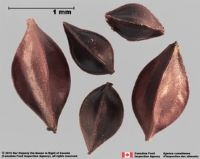 , usually 5–8 achenesachene:
, usually 5–8 achenesachene:
a dry, indehiscent, one-seeded fruit, with seed attached to pericarp at a single point, derived from a single, superior, simple or compound, one-loculed ovary mature in globoseglobose:
mature in globoseglobose:
3D shape—more or less spherical head. AchenesAchene:
head. AchenesAchene:
a dry, indehiscent, one-seeded fruit, with seed attached to pericarp at a single point, derived from a single, superior, simple or compound, one-loculed ovary fall individually, 5–11 mm long, narrowly conicalconical:
fall individually, 5–11 mm long, narrowly conicalconical:
3D shape—cone-shaped, with the point of attachment at the broad end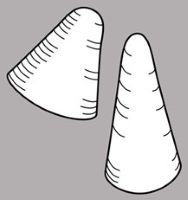 to linearlinear:
to linearlinear:
(shape) long, narrow, and uniform in width; (of embryo) embryo is straight and much longer than wide , claviformclaviform:
, claviformclaviform:
3D shape—club-shaped
, or quadrangularquadrangular:
2D shape—four-sided, as in a square or rectangle , tereteterete:
, tereteterete:
approximately circular in cross section; width and thickness approximately equal
 in transection, stylestyle:
in transection, stylestyle:
in a flower, the narrow and elongated part of the pistil between the stigma and the ovary; sometimes persisting in fruit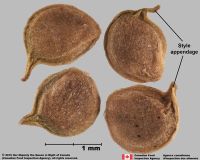 often persistent forming beakbeak:
often persistent forming beakbeak:
a usually firm, terminal appendage, sometimes tapered , with one seed, subtended by tuft of long hairs. Pericarppericarp:
, with one seed, subtended by tuft of long hairs. Pericarppericarp:
fruit wall or fruit coat
brown or yellow, dulldull:
reflecting only a low proportion of incident light, with no apparent sheen , leatheryleathery:
, leatheryleathery:
texture—moderately thick, tough, and very pliable
, glabrousglabrous:
without hairs
or pubescentpubescent:
surface relief—bearing hairs
, glabrousglabrous:
without hairs
achenesachene:
a dry, indehiscent, one-seeded fruit, with seed attached to pericarp at a single point, derived from a single, superior, simple or compound, one-loculed ovary may appear hairy from tuft of hairs at base, smooth.
may appear hairy from tuft of hairs at base, smooth.
Seeds fusiformfusiform:
spindle-shaped; broadest at the middle and tapering at both ends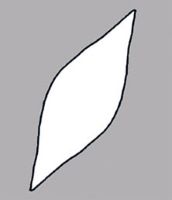 to linearlinear:
to linearlinear:
(shape) long, narrow, and uniform in width; (of embryo) embryo is straight and much longer than wide , tereteterete:
, tereteterete:
approximately circular in cross section; width and thickness approximately equal
 in transection, 1 to less than 5 mm long. Seed coat thin, membranousmembranous:
in transection, 1 to less than 5 mm long. Seed coat thin, membranousmembranous:
texture—extremely thin, pliable, and fairly tough
, glabrousglabrous:
without hairs
.
Embryo well developed, completely or nearly completely filling seed coat, axileaxile:
on or of the axis
and centric, linearlinear:
(shape) long, narrow, and uniform in width; (of embryo) embryo is straight and much longer than wide , straight. Cotyledons thin, not foliaceous, circinatecircinate:
, straight. Cotyledons thin, not foliaceous, circinatecircinate:
3D shape—terete and rolled downward from the apex in a tight coil
to each other.
Endosperm scanty.
| Fruit | |
| Type | acheneachene: a dry, indehiscent, one-seeded fruit, with seed attached to pericarp at a single point, derived from a single, superior, simple or compound, one-loculed ovary  |
| Size range | 5–11 mm long |
| Shape(s) | narrowly conicalconical: 3D shape—cone-shaped, with the point of attachment at the broad end  , linearlinear: , linearlinear:(shape) long, narrow, and uniform in width; (of embryo) embryo is straight and much longer than wide  , quadrangularquadrangular: , quadrangularquadrangular:2D shape—four-sided, as in a square or rectangle  , claviformclaviform: , claviformclaviform:3D shape—club-shaped |
| Texture | fleshy, spongyspongy: soft, light, discontinuous but cohesive, and somewhat resilient |
| Color(s) | black, brown, green, yellow |
| Unique features | Fleshy or spongyspongy: soft, light, discontinuous but cohesive, and somewhat resilient , often beakedbeak: a usually firm, terminal appendage, sometimes tapered  , one-seeded folliclesfollicle: , one-seeded folliclesfollicle:a dry to (rarely) fleshy fruit derived from a single carpel that opens along a single longitudinal suture, derived from a single, superior, simple ovary; the seeds may be arillate or with a fleshy testa 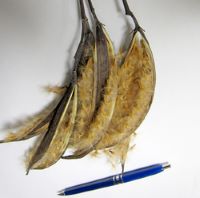 or indehiscentindehiscent: or indehiscentindehiscent:not opening on its own, as in a fruit 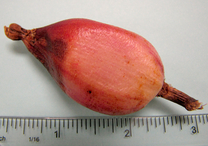 drupesdrupe: drupesdrupe:(indehiscent drupe) a fleshy, indehiscent fruit with one more hard pits enclosing seeds, derived from single, superior, simple or compound ovary; (dehiscent drupe) a fruit with a dry or fibrous to fleshy or leathery outer husk that early to tardily breaks apart (or opens), exposing one or more nutlike pits enclosing the seeds 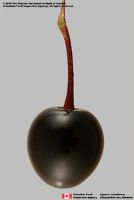 . . |
| Seed | |
| Size range | 1 mm to less than 5 mm |
| Shape(s) | fusiformfusiform: spindle-shaped; broadest at the middle and tapering at both ends  , linearlinear: , linearlinear:(shape) long, narrow, and uniform in width; (of embryo) embryo is straight and much longer than wide  |
| Other | |
| Embryo | well developed, completely or nearly completely filling seed coat, axileaxile: on or of the axis and centric, linearlinear: (shape) long, narrow, and uniform in width; (of embryo) embryo is straight and much longer than wide  , straight. Cotyledons thin, not foliaceous, circinatecircinate: , straight. Cotyledons thin, not foliaceous, circinatecircinate:3D shape—terete and rolled downward from the apex in a tight coil to each other. |
| Nutritive tissue | endosperm scanty |
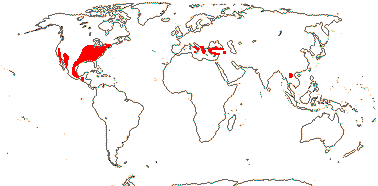
Distribution map courtesy of Angiosperm Phylogeny Website.
Flora of North America Editorial Committee 1993+Flora of North America Editorial Committee 1993+:
Flora of North America Editorial Committee, eds. 1993+. Flora of North America North of Mexico [Online]. 22+ vols. Flora of North America Association, New York and Oxford. Accessed January-March 2024. URL: http://beta.floranorthamerica.org.; Kirkbride et al. 2006Kirkbride et al. 2006:
Kirkbride JH, Jr, Gunn CR, and Dallwitz MJ. 2006. Family guide for fruits and seeds, vers. 1.0. Accessed September 2020-January 2022. URL: https://nt.ars-grin.gov/seedsfruits/keys/frsdfam/index.cfm .; Kubitzki et al. 1990+Kubitzki et al. 1990+:
Kubitzki K et al., eds. 1990+. The families and genera of vascular plants. 7+ vols. Berlin etc.; Nixon and Poole 2003Nixon and Poole 2003:
Nixon KC and Poole JC. 2003. Revision of the Mexican and Guatemalan species of Platanus (Platanaceae). Lundellia 2003(6): 103&-137.; Takhtajan 2009Takhtajan 2009:
Takhtajan A. 2009. Flowering plants: Second edition. Springer Nature, Switzerland. 871 pp.; Zhengyi et al. 2004+Zhengyi et al. 2004+:
Zhengyi W, Raven PH, and Deyuan H. 2004+. Flora of China [online]. 25 vols. Science Press, Beijing China & Missouri Botanical Garden, St. Louis USA. Accessed January–March 2024. http://flora.huh.harvard.edu/china/
*The number of genera and species is based on Christenhusz and Byng 2016Christenhusz and Byng 2016:
Christenhusz MJM and Byng JW. 2016. The number of known plant species in the world and its annual increase. Phytotaxa 261 (3): 201-217. https://doi.org/10.11646/phytotaxa.261.3.1, which may differ from the number of genera in GRIN-Global.